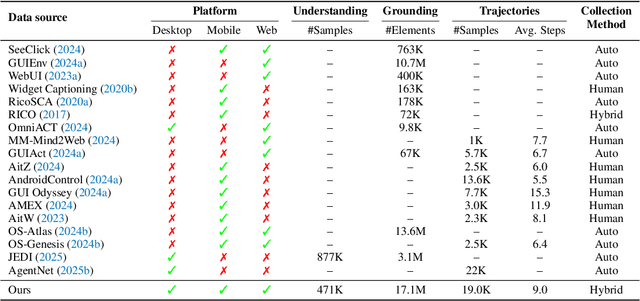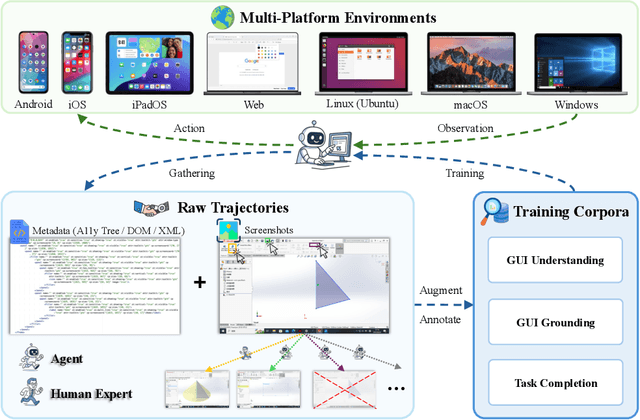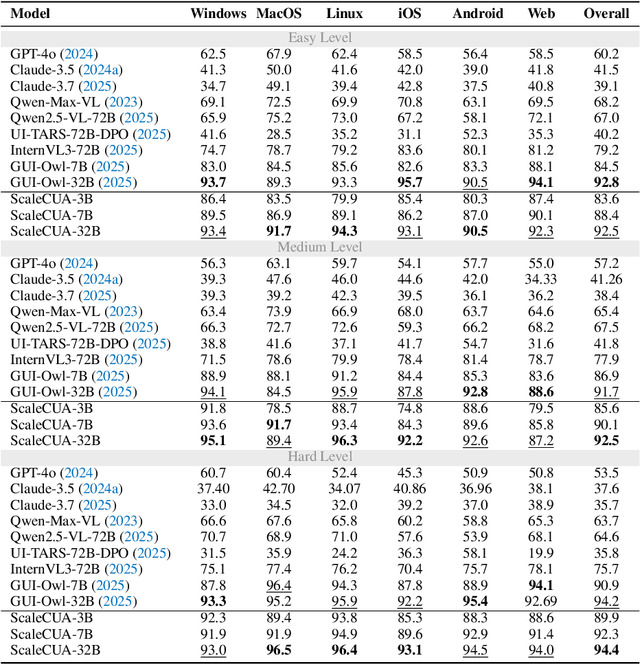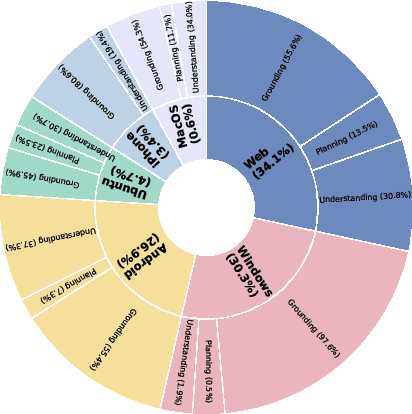Kai Chen
DynaSolidGeo: A Dynamic Benchmark for Genuine Spatial Mathematical Reasoning of VLMs in Solid Geometry
Oct 25, 2025Abstract:Solid geometry problem solving demands spatial mathematical reasoning that integrates spatial intelligence and symbolic reasoning. However, most existing multimodal mathematical reasoning benchmarks focus primarily on 2D plane geometry, rely on static datasets prone to data contamination and memorization, and evaluate models solely by final answers, overlooking the reasoning process. To address these limitations, we introduce DynaSolidGeo, the first dynamic benchmark for evaluating genuine spatial reasoning in Vision-Language Models (VLMs). Constructed through a semi-automatic annotation pipeline, DynaSolidGeo contains 503 expert-curated seed questions that can, in principle, dynamically generate an unbounded number of diverse multimodal text-visual instances. Beyond answer accuracy, we incorporate process evaluation based on expert-annotated reasoning chains to measure logical validity and causal coherence. Experiments across representative open-source and closed-source VLMs reveal large performance gaps, severe degradation in dynamic settings, and poor performance on tasks requiring high-level spatial intelligence, such as mental rotation and visualization. The code and dataset are available at \href{https://zgca-ai4edu.github.io/DynaSolidGeo/}{DynaSolidGeo}.
MinerU2.5: A Decoupled Vision-Language Model for Efficient High-Resolution Document Parsing
Sep 26, 2025Abstract:We introduce MinerU2.5, a 1.2B-parameter document parsing vision-language model that achieves state-of-the-art recognition accuracy while maintaining exceptional computational efficiency. Our approach employs a coarse-to-fine, two-stage parsing strategy that decouples global layout analysis from local content recognition. In the first stage, the model performs efficient layout analysis on downsampled images to identify structural elements, circumventing the computational overhead of processing high-resolution inputs. In the second stage, guided by the global layout, it performs targeted content recognition on native-resolution crops extracted from the original image, preserving fine-grained details in dense text, complex formulas, and tables. To support this strategy, we developed a comprehensive data engine that generates diverse, large-scale training corpora for both pretraining and fine-tuning. Ultimately, MinerU2.5 demonstrates strong document parsing ability, achieving state-of-the-art performance on multiple benchmarks, surpassing both general-purpose and domain-specific models across various recognition tasks, while maintaining significantly lower computational overhead.
ScaleCUA: Scaling Open-Source Computer Use Agents with Cross-Platform Data
Sep 18, 2025



Abstract:Vision-Language Models (VLMs) have enabled computer use agents (CUAs) that operate GUIs autonomously, showing great potential, yet progress is limited by the lack of large-scale, open-source computer use data and foundation models. In this work, we introduce ScaleCUA, a step toward scaling open-source CUAs. It offers a large-scale dataset spanning 6 operating systems and 3 task domains, built via a closed-loop pipeline uniting automated agents with human experts. Trained on this scaled-up data, ScaleCUA can operate seamlessly across platforms. Specifically, it delivers strong gains over baselines (+26.6 on WebArena-Lite-v2, +10.7 on ScreenSpot-Pro) and sets new state-of-the-art results (94.4% on MMBench-GUI L1-Hard, 60.6% on OSWorld-G, 47.4% on WebArena-Lite-v2). These findings underscore the power of data-driven scaling for general-purpose computer use agents. We will release data, models, and code to advance future research: https://github.com/OpenGVLab/ScaleCUA.
CODA: Coordinating the Cerebrum and Cerebellum for a Dual-Brain Computer Use Agent with Decoupled Reinforcement Learning
Aug 27, 2025Abstract:Autonomous agents for Graphical User Interfaces (GUIs) face significant challenges in specialized domains such as scientific computing, where both long-horizon planning and precise execution are required. Existing approaches suffer from a trade-off: generalist agents excel at planning but perform poorly in execution, while specialized agents demonstrate the opposite weakness. Recent compositional frameworks attempt to bridge this gap by combining a planner and an actor, but they are typically static and non-trainable, which prevents adaptation from experience. This is a critical limitation given the scarcity of high-quality data in scientific domains. To address these limitations, we introduce CODA, a novel and trainable compositional framework that integrates a generalist planner (Cerebrum) with a specialist executor (Cerebellum), trained via a dedicated two-stage pipeline. In the first stage, Specialization, we apply a decoupled GRPO approach to train an expert planner for each scientific application individually, bootstrapping from a small set of task trajectories. In the second stage, Generalization, we aggregate all successful trajectories from the specialized experts to build a consolidated dataset, which is then used for supervised fine-tuning of the final planner. This equips CODA with both robust execution and cross-domain generalization. Evaluated on four challenging applications from the ScienceBoard benchmark, CODA significantly outperforms baselines and establishes a new state of the art among open-source models.
Building Self-Evolving Agents via Experience-Driven Lifelong Learning: A Framework and Benchmark
Aug 26, 2025Abstract:As AI advances toward general intelligence, the focus is shifting from systems optimized for static tasks to creating open-ended agents that learn continuously. In this paper, we introduce Experience-driven Lifelong Learning (ELL), a framework for building self-evolving agents capable of continuous growth through real-world interaction. The framework is built on four core principles: (1) Experience Exploration: Agents learn through continuous, self-motivated interaction with dynamic environments, navigating interdependent tasks and generating rich experiential trajectories. (2) Long-term Memory: Agents preserve and structure historical knowledge, including personal experiences, domain expertise, and commonsense reasoning, into a persistent memory system. (3) Skill Learning: Agents autonomously improve by abstracting recurring patterns from experience into reusable skills, which are actively refined and validated for application in new tasks. (4) Knowledge Internalization: Agents internalize explicit and discrete experiences into implicit and intuitive capabilities as "second nature". We also introduce StuLife, a benchmark dataset for ELL that simulates a student's holistic college journey, from enrollment to academic and personal development, across three core phases and ten detailed sub-scenarios. StuLife is designed around three key paradigm shifts: From Passive to Proactive, From Context to Memory, and From Imitation to Learning. In this dynamic environment, agents must acquire and distill practical skills and maintain persistent memory to make decisions based on evolving state variables. StuLife provides a comprehensive platform for evaluating lifelong learning capabilities, including memory retention, skill transfer, and self-motivated behavior. Beyond evaluating SOTA LLMs on the StuLife benchmark, we also explore the role of context engineering in advancing AGI.
InternVL3.5: Advancing Open-Source Multimodal Models in Versatility, Reasoning, and Efficiency
Aug 25, 2025Abstract:We introduce InternVL 3.5, a new family of open-source multimodal models that significantly advances versatility, reasoning capability, and inference efficiency along the InternVL series. A key innovation is the Cascade Reinforcement Learning (Cascade RL) framework, which enhances reasoning through a two-stage process: offline RL for stable convergence and online RL for refined alignment. This coarse-to-fine training strategy leads to substantial improvements on downstream reasoning tasks, e.g., MMMU and MathVista. To optimize efficiency, we propose a Visual Resolution Router (ViR) that dynamically adjusts the resolution of visual tokens without compromising performance. Coupled with ViR, our Decoupled Vision-Language Deployment (DvD) strategy separates the vision encoder and language model across different GPUs, effectively balancing computational load. These contributions collectively enable InternVL3.5 to achieve up to a +16.0\% gain in overall reasoning performance and a 4.05$\times$ inference speedup compared to its predecessor, i.e., InternVL3. In addition, InternVL3.5 supports novel capabilities such as GUI interaction and embodied agency. Notably, our largest model, i.e., InternVL3.5-241B-A28B, attains state-of-the-art results among open-source MLLMs across general multimodal, reasoning, text, and agentic tasks -- narrowing the performance gap with leading commercial models like GPT-5. All models and code are publicly released.
InternBootcamp Technical Report: Boosting LLM Reasoning with Verifiable Task Scaling
Aug 12, 2025



Abstract:Large language models (LLMs) have revolutionized artificial intelligence by enabling complex reasoning capabilities. While recent advancements in reinforcement learning (RL) have primarily focused on domain-specific reasoning tasks (e.g., mathematics or code generation), real-world reasoning scenarios often require models to handle diverse and complex environments that narrow-domain benchmarks cannot fully capture. To address this gap, we present InternBootcamp, an open-source framework comprising 1000+ domain-diverse task environments specifically designed for LLM reasoning research. Our codebase offers two key functionalities: (1) automated generation of unlimited training/testing cases with configurable difficulty levels, and (2) integrated verification modules for objective response evaluation. These features make InternBootcamp fundamental infrastructure for RL-based model optimization, synthetic data generation, and model evaluation. Although manually developing such a framework with enormous task coverage is extremely cumbersome, we accelerate the development procedure through an automated agent workflow supplemented by manual validation protocols, which enables the task scope to expand rapidly. % With these bootcamps, we further establish Bootcamp-EVAL, an automatically generated benchmark for comprehensive performance assessment. Evaluation reveals that frontier models still underperform in many reasoning tasks, while training with InternBootcamp provides an effective way to significantly improve performance, leading to our 32B model that achieves state-of-the-art results on Bootcamp-EVAL and excels on other established benchmarks. In particular, we validate that consistent performance gains come from including more training tasks, namely \textbf{task scaling}, over two orders of magnitude, offering a promising route towards capable reasoning generalist.
Undress to Redress: A Training-Free Framework for Virtual Try-On
Aug 11, 2025Abstract:Virtual try-on (VTON) is a crucial task for enhancing user experience in online shopping by generating realistic garment previews on personal photos. Although existing methods have achieved impressive results, they struggle with long-sleeve-to-short-sleeve conversions-a common and practical scenario-often producing unrealistic outputs when exposed skin is underrepresented in the original image. We argue that this challenge arises from the ''majority'' completion rule in current VTON models, which leads to inaccurate skin restoration in such cases. To address this, we propose UR-VTON (Undress-Redress Virtual Try-ON), a novel, training-free framework that can be seamlessly integrated with any existing VTON method. UR-VTON introduces an ''undress-to-redress'' mechanism: it first reveals the user's torso by virtually ''undressing,'' then applies the target short-sleeve garment, effectively decomposing the conversion into two more manageable steps. Additionally, we incorporate Dynamic Classifier-Free Guidance scheduling to balance diversity and image quality during DDPM sampling, and employ Structural Refiner to enhance detail fidelity using high-frequency cues. Finally, we present LS-TON, a new benchmark for long-sleeve-to-short-sleeve try-on. Extensive experiments demonstrate that UR-VTON outperforms state-of-the-art methods in both detail preservation and image quality. Code will be released upon acceptance.
CharacterShot: Controllable and Consistent 4D Character Animation
Aug 10, 2025Abstract:In this paper, we propose \textbf{CharacterShot}, a controllable and consistent 4D character animation framework that enables any individual designer to create dynamic 3D characters (i.e., 4D character animation) from a single reference character image and a 2D pose sequence. We begin by pretraining a powerful 2D character animation model based on a cutting-edge DiT-based image-to-video model, which allows for any 2D pose sequnce as controllable signal. We then lift the animation model from 2D to 3D through introducing dual-attention module together with camera prior to generate multi-view videos with spatial-temporal and spatial-view consistency. Finally, we employ a novel neighbor-constrained 4D gaussian splatting optimization on these multi-view videos, resulting in continuous and stable 4D character representations. Moreover, to improve character-centric performance, we construct a large-scale dataset Character4D, containing 13,115 unique characters with diverse appearances and motions, rendered from multiple viewpoints. Extensive experiments on our newly constructed benchmark, CharacterBench, demonstrate that our approach outperforms current state-of-the-art methods. Code, models, and datasets will be publicly available at https://github.com/Jeoyal/CharacterShot.
IFDECORATOR: Wrapping Instruction Following Reinforcement Learning with Verifiable Rewards
Aug 06, 2025Abstract:Reinforcement Learning with Verifiable Rewards (RLVR) improves instruction following capabilities of large language models (LLMs), but suffers from training inefficiency due to inadequate difficulty assessment. Moreover, RLVR is prone to over-optimization, where LLMs exploit verification shortcuts without aligning to the actual intent of user instructions. We introduce Instruction Following Decorator (IFDecorator}, a framework that wraps RLVR training into a robust and sample-efficient pipeline. It consists of three components: (1) a cooperative-adversarial data flywheel that co-evolves instructions and hybrid verifications, generating progressively more challenging instruction-verification pairs; (2) IntentCheck, a bypass module enforcing intent alignment; and (3) trip wires, a diagnostic mechanism that detects reward hacking via trap instructions, which trigger and capture shortcut exploitation behaviors. Our Qwen2.5-32B-Instruct-IFDecorator achieves 87.43% accuracy on IFEval, outperforming larger proprietary models such as GPT-4o. Additionally, we demonstrate substantial improvements on FollowBench while preserving general capabilities. Our trip wires show significant reductions in reward hacking rates. We will release models, code, and data for future research.
 Add to Chrome
Add to Chrome Add to Firefox
Add to Firefox Add to Edge
Add to Edge